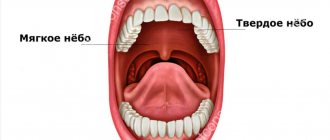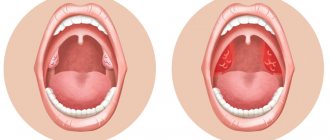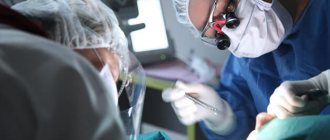Inflammation of the lymph nodes is an extremely unpleasant phenomenon. Acute painful sensations associated with this condition can disrupt the usual course of affairs for quite a long time. The pain with normal movements can seem endless. It is physically exhausting and therefore the course of the disease worsens and seems unbearable. To figure out what to do in this case, it is first of all important to understand the causes of inflammation of the lymph nodes and learn to distinguish the symptoms of this condition - otherwise it will simply be impossible to choose the right treatment.
Symptoms of pathology
The fact that a person has “caught” a lymph node usually means its increase in size. Occasionally it hurts, and the skin over it becomes red. In this case, doctors talk about lymphadenitis.
An important point is the mobility of the lymph node. Normally, it easily moves a short distance. If the lymph node is motionless and enlarged, a doctor’s consultation is urgently needed.
Not all lymph nodes can be examined independently. When magnified, they can be felt on the neck, under the armpits, and in the groin area. It is important where the inflamed area is located. If a lymph node in the neck has caught a cold, how to treat it will differ from the situation when the groin or axillary area is affected. By localization, one can judge a preliminary diagnosis, since lymphadenopathy is often only a symptom of the underlying disease.
What diseases does it occur in?
First, you need to look for inflammation near the affected lymph node. Usually bacteria or viruses enter it from a nearby organ.
Diseases in which the cervical lymph node becomes inflamed:
- acute respiratory infections and acute respiratory viral infections;
- tonsillitis (acute or chronic);
- dental diseases (focus of infection in the mouth).
Enlarged inguinal lymph nodes are often associated with sexually transmitted diseases, including herpes infection. Axillary units are inflamed with hidradenitis - a pathology of the sweat glands.
Sometimes inflammation of the lymph node occurs against the background of a general weakened state of the body. This is observed in malignant neoplasms, blood pathologies, HIV infection and viral hepatitis B.
In a chronic specific inflammatory disease, an enlarged lymph node is a normal variant. This is a reaction to the underlying pathological process and does not require treatment.
Enlargement of more than one lymph node often indicates infection. This is how tuberculosis, syphilis, and tularemia manifest themselves. Inflammation of a large number of lymph nodes indicates a serious infectious process - HIV, toxoplasmosis, brucellosis, CMV, mononucleosis and others. This requires urgent consultation with an infectious disease specialist.
What to do if the lymph nodes in the neck are inflamed: causes and treatment
Lymphadenitis is an inflammation of the lymph nodes in the neck; we will talk about the symptoms, treatment and causes of the disease in the article.
The job of the lymph nodes is to filter lymph along the bloodstream so that pathogens do not reach vital organs. It is thanks to them that a large number of lymphocytes, that is, cells of the immune system, appear in the blood. When a patient falls ill, their number increases significantly, and along with them, the spherical nodules that are located in the groin, in the elbow and knee bends, in the sternum and abdominal cavity become larger in size. But the most important lymph nodes are located in the neck. They protect the main veins and arteries so that the infection does not penetrate the brain.
Types of lymphadenitis
The disease can be called an auxiliary condition and even a symptom of something more dangerous, because it does not occur on its own, but only in combination with another inflammatory diagnosis.
When the immune system in the human body fails and a focus of disease forms, pathogens travel through the bloodstream to one of the lymph nodes. In this territory, with the help of leukocytes and lymphocytes, the sick person wins. But if the cause is strong enough and foreign pathogenic agents appear in large quantities, then the first signs of inflammation of the lymph nodes in the neck appear, namely, their increase in size. This occurs due to the active production of immune cells.
But depending on the location, severity and method of infection, there are several classifications.
By method of infection:
- hematogenous, that is, through the blood, when a lesion appears in one part of the body, and the pathogen reaches the lymph node through the veins or arteries;
- contact, occurs in cases where nearby organs, for example, the nasopharynx, are infected;
- mechanical - due to damage to tissues and skin near the lymph node with subsequent penetration of the pathogen.
According to the source of infection, lymphadenitis occurs:
- Specific. The most classic clinical picture is when the patient has swollen cervical lymph drainages due to infection with candida or bacteria. Usually these are staphylococci or streptococci, that is, the most common pathogens of sore throat, tonsillitis and other colds.
- Non-specific. Pathology develops as an exacerbation of diseases that lead to a sharp decrease in the immune system. This often happens with HIV or tuberculosis. In this case, in addition to treating the underlying disease, a significant dose of immunostimulants is prescribed.
According to the severity of the flow:
- Spicy. It is characterized by the rapid onset of swelling, pain and severe inflammation of the cervical lymph nodes. Symptoms intensify rapidly and may affect nearby nodes. If treatment is incorrect or untimely, serious complications can occur.
- Chronic. This is a long-term course of the disease with increasing symptoms and risks of progressive morbidity. Typically, this stage begins in cases where proper treatment was not carried out at the initial stage of the inflammatory process.
- Reactive, that is, very fast. The process lives up to its name because, apart from swelling and pain in the ear or jaw area, there are no other signs of the disease.
According to the clinical picture:
- Purulent - the bacterial focus is located next to the immune defense organs, so if pus occurs, it can also affect them. The active reproduction of pathogens also continues in the lymph nodes. Without urgent antibiotic therapy or, in some cases, without surgical intervention, there is a high risk of abscess rupture. As a result, the pathogenic mass can reach vital organs, including the brain.
- Catarrhal. Occurs with significant redness of soft tissues. This happens due to the fact that blood capillaries burst, releasing blood.
- Granulomatous. Granulomas are clots of blood and lymphatic cells that are mixed into a single mass. They often appear on the skin in the form of plaques, reddish spots, and rashes.
- Serous. A cloudy sediment is released in the tissues. The exudate partly consists of lymphocytes. This leads to a general deterioration in health, as the immune system actually stops working. Also, in this condition, inflammation of the lymph nodes on the right and left neck occurs very rapidly, they can reach significant sizes.
- Hyperplastic. This is such an advanced stage of the disease, when the volume of the node grows from the classic 2-3 millimeters to several centimeters.
- Necrotic. The most dangerous type because it causes cells to die.
By the number of affected lymphatic drainages:
- single - only one area is affected;
- regional, also known as multiple – damage to an entire region;
- total – all or most of the groups of lymph nodes throughout the body.
Another classification divides ailments by location. But we will focus only on the cervical-collar area.
Symptoms of increased lymphoid tissue
With lymphadenitis, it is considered normal if the inflammatory process occurs symmetrically. If, on the contrary, the lesion is only in one direction, then there is a risk that the pathology is of an oncological nature. But before contacting an oncologist, you should pay attention to the symptoms. Classic manifestations:
- Temperature increase. As with any other inflammation, leukocytes begin to be actively produced to fight infection. Their concentration in the body, together with toxic waste products of bacteria, leads to symptoms of intoxication. That is, to weakness, drowsiness, low fever, and an apathetic state. All this goes along with a fever, which usually does not reach more than 38.5 degrees. If the thermometer reads over 39, you should immediately consult a doctor. In some cases, this may be caused by a concomitant disease, such as tonsillitis. But if the throat does not hurt, then such a high temperature may indicate a purulent or serous nature of the disease, which is dangerous.
- Upon palpation, pronounced bumps can be detected. They can be small and increase over time.
- All soft tissues of the neck swell slightly. The swelling puts pressure on the larynx, making it difficult for the patient to speak and swallow.
- When turning or tilting the head, the pain intensifies.
All these symptoms are characteristic of a condition such as lymphadenopathy. This diagnosis should not be confused with lymphoma, that is, with cancer. But you should be examined for possible cancer.
Side symptoms may include:
- enlargement of the tonsils and their pain when swallowing;
- swelling of the salivary and lacrimal glands;
- swelling of the thyroid gland.
If you see such manifestations in yourself, your loved ones or your child, you should immediately visit a doctor. We strongly do not recommend using methods that increase body temperature as self-medication. Also, you should not carry out procedures that involve heating the lymph nodes. That is, you cannot make compresses, lotions or steam baths for your feet. This can only make the situation worse.
Before being examined by a specialist, you can start taking the immunomodulator Cytovir-3. This is a domestically produced drug that has virtually no contraindications or possible negative consequences. It should be taken for 4 days to increase endogenous interferon levels. Active substances (bendazole, thymogen and ascorbic acid) stimulate the natural production of protective proteins. This will ease the course of the disease and help in recovery.
What to do and who to go to if you have inflammation of the lymph nodes in the neck
If the symptoms are closely related to catarrhal or purulent tonsillitis, tonsillitis, pharyngitis, sinusitis or classic sinusitis, then we can talk about the probable connection of these diseases with lymphadenitis. Most likely, after a full course of treatment for colds of the upper respiratory tract of a bacterial nature, the inflammatory process will also pass. Therefore, you should contact a therapist or ENT specialist.
The following can also work in tandem with them:
- immunologist - we have already noted that lymphoid tissues are closely related to immunity;
- infectious disease specialist - to determine the type of infection;
- oncologist - referred to him in rare cases of reactive lymphadenopathy or other signs of possible lymphoma.
Diagnostics
The specialist will ask you to name the symptoms, ask when the first signs appeared, and also with what intensity they are now bothering you. He then palpates the affected area to determine the diameter of the lymph nodes. If a non-infectious cause is suspected, an ultrasound may be ordered. You will also need to donate blood and urine to check for an increased number of white blood cells and the presence of toxic substances.
The immunologist will also do an immunogram. This test will help give an objective picture of the state of your immune system. In case of poor or insufficiently satisfactory results, immunomodulators may be prescribed.
Causes of inflammation of the lymph nodes in the neck in an adult woman or man
In diseases of the upper respiratory tract, an inflammatory process occurs, which leads to the spread of infection through the bloodstream. And since the cervical lymph drainage is closest to the site of infection, the inflammatory process occurs there first. Therefore, the first and main reason is the accompaniment of such diagnoses as tonsillitis or tonsillitis. And the stronger the disease, the larger the tumor becomes, the pain intensifies, and upon palpation you can feel dense lymphoid tissue the size of a walnut or even a chicken egg.
But not only bacteria can become the causative agent of lymphadenitis. This can lead to:
- HIV;
- cancer metastases;
- Sharp's syndrome or other connective tissue pathologies;
- frequent consumption of alcoholic beverages;
- chronic immune problems and frequent illnesses;
- disorders of the thyroid gland;
- otitis media;
- caries or other dental infections;
- STD.
Mechanical damage to the skin, for example, a scratch from a rodent or pet, can also lead to such a reaction in the body. Let's take a closer look at the possible reasons depending on the location.
On right
- infectious diseases of the throat;
- failure of one side of the thyroid gland;
- inflammation of the right tonsil;
- caries.
Left
In addition to the above-mentioned factors, which can occur on both halves, left-sided swelling may indicate disturbances in the gastrointestinal tract and abdominal cavity. Can be diagnosed:
- cytomegalovirus;
- toxoplasmosis.
Behind
If the pain radiates to the occipital region, then there is a high probability that the patient has infectious mononucleosis, which develops under the influence of the Epstein-Barr virus.
This is a very dangerous diagnosis, which may cause photophobia, facial swelling, cough, chills, fever, red throat and cough. Due to the enlargement of the spleen, the stomach begins to ache.
Behind the ear
The reasons may be:
- otitis;
- mumps;
- rubella;
- boil or other purulent formations on the ear canal.
Under the jaw
The submandibular nodes become inflamed, as a rule, with serious disorders of the immune system or with frequent or chronic diseases. This can be caused by:
- arthritis;
- Wagner's syndrome;
- lupus erythematosus;
- serum sickness.
Treatment of inflammation of the lymph nodes in the neck in an adult
If you have an elevated temperature, you should take antipyretics. At the same time, therapists do not recommend taking medications up to 38.5 degrees, since such a mark indicates an active independent fight of the body against pathogens. In case of extreme heat, you can take antipyretics: Paracetamol, Voltaren, Ibuklin.
If the cause is otitis media, caries, boils or other concomitant diseases, then you need to cure them first, then the swelling will subside over time on its own.
In case of chronic lymphadenitis, an immunogram should be done, since the main reason is reduced immunity. You should start taking immunomodulators. The drug “Tsitovir-3” has a good effect from this category of drugs. It quickly and efficiently increases the level of interferon in the blood, which facilitates the work of the lymph nodes.
In case of purulent course of the disease, you should strictly follow the specialist’s recommendations. He can assign:
- Antibiotics intravenously or orally. It is imperative to finish the prescribed amount of medication, otherwise there is a risk of relapse.
- Bed rest. For children, as well as for patients with an advanced stage of the disease or complications, hospitalization will be required.
- Surgery - in rare cases, when there is a risk of abscess rupture.
- Physiotherapeutic procedures using stimulation of lymphoid tissue with current or laser.
If the inflammation is caused by a virus, then antiviral drugs may be prescribed.
In rare cases, Prednisolone is prescribed. It helps replenish the secretion that is secreted by the adrenal glands and regulates the level of leukocytes and lymphocytes.
Among the external methods of therapy, the following ointments can be distinguished:
- "Heparin".
- "Vishnevsky".
- "Diclofenac".
They relieve inflammation and relieve pain. It should be noted that they should be used only in combination with tablets.
Complications
Since lymphatic drainage clears the bloodstream of infection, if the functioning of the lymph nodes is disrupted, there is a high probability that pathogens will spread throughout the body and affect vital organs. If they reach the brain, meningitis may begin.
The second danger is sepsis, that is, blood poisoning. Such a consequence may occur after the purulent course of the disease.
When entering the chronic stage, relapses may occur frequently, and the immune system will be greatly weakened.
Prevention
As a preventive measure, you should strengthen your immune system and try to avoid upper respiratory tract diseases. Need to:
- Eat properly. Your diet should include fresh vegetables and fruits every day. Eliminate fast food and soda.
- Maintain hygiene. Wash your hands after every visit to public places with large crowds of people.
- Gradually harden.
- Strengthen your body through exercise and sports.
- Walk outdoors more often.
- Take a course of Cytovir-3 2-3 times a year.
In the article, we explained what types of lymphadenitis there are, what causes it, and how to treat inflammation of the lymph nodes in the neck. Be attentive to your health and consult a doctor at the first signs.
Diagnostics
The first thing to do if a lymph node is inflamed is to visit a doctor. He will inspect not only the disturbing group, but also the neighboring ones. It’s easy to miss this on your own, but detecting such changes will help make a diagnosis. If several lymph nodes are affected, the mucous membranes and skin are also examined for rashes.
The phased examination includes:
- General and biochemical blood test, general urine test.
- Testing for hepatitis B and C, HIV, syphilis.
- Fluorography, if necessary, an x-ray of the lungs.
- Ultrasound of the abdominal organs.
- Ultrasound of lymph nodes.
- Biopsy of lymph node tissue.
Based on the research results, a diagnosis is made and treatment tactics are formulated.
Clinical picture
Cervical lymphadenopathy is accompanied not only by dull, aching pain, the intensity of which increases with pressure. When palpated, you can detect a small elastic, elastic and movable seal. If the inflammatory process worsens, the size of the formation increases. Sometimes they exceed 5 cm and the compaction is clearly visible. Unlike malignant tumors, such a formation with unclear contours has a dense, tuberous structure. Lymphadenopathy is also characterized by other signs:
- when swallowing food, painful sensations occur;
- the skin above the seal becomes even and red.
In response to the penetration of foreign proteins into the body, symptoms of general intoxication develop. Body temperature rises to subfebrile levels (37.5°C), headaches, weakness, fatigue, and dyspeptic disorders occur.
Inflammation and pain in the cervical nodes in children should be a signal to immediately consult a doctor. The immune system of babies is just developing, so it is not able to cope with infectious agents. In the absence of medical care, chronic lymphadenitis develops. It is usually detected by chance, when palpating the lymph nodes, which are always slightly enlarged.
The acute inflammatory process in the lymph nodes in children is much more severe than in adults. The temperature rises, the neck swells, and sometimes a fever occurs. The pain when swallowing is so acute that the child refuses not only to eat, but also to drink.
Treatment
If a patient has a cold lymph node, treatment is selected taking into account the underlying disease. The treatment regimen depends on the type of pathogen.
Treatment methods:
- Antibiotic therapy - for bacterial infection.
- Antiretroviral drugs - for HIV and AIDS.
- Antiherpetic drugs - for herpetic infection.
- Antimycotics - for fungal infections.
- Bed rest and plenty of warm drinks - for mild ARVI.
Self-medication is dangerous not only due to the incorrect selection of drugs, but also the development of the underlying disease. It is better to detect it early and treat it than to waste time and money on inappropriate medications.
Read also: Dry paroxysmal cough
Dear patients! Remember that only a qualified doctor can make an accurate diagnosis, determine the causes and nature of the disease, and prescribe effective treatment. You can make an appointment with our specialists or call a doctor at home by calling 8-(4822)-33-00-33
Be healthy and happy!










